Deep history from the genomes of India
People carrying Neanderthal mixture entered the subcontinent after 50,000 years ago, meeting Denisovans
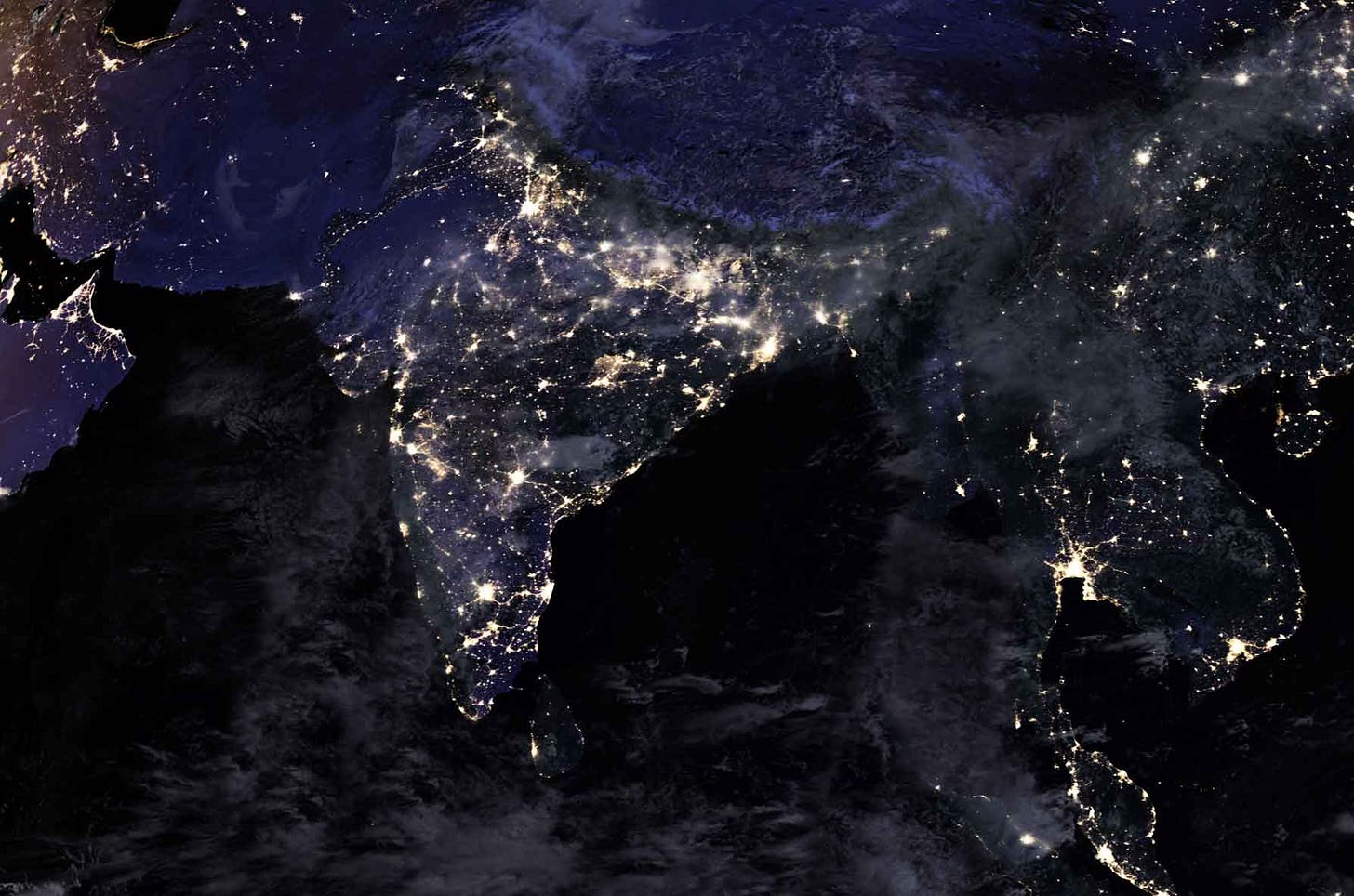
Within the few thousand years after 50,000 years ago, a small founder population was mixing its genes with an even smaller number of Neanderthals, somewhere in southwestern Asia. That small founder group then ballooned in numbers: Starting at only one or two thousand it grew to tens and then hundreds of thousands. Some percolated northward into the steppes, diverting east and west to the ends of Eurasia.
Getting an even faster start were a growing flood of descendants who entered Southeast Asia, hopping along coastlines until they reached Australia and Papua. This pathway led first across the Indian subcontinent. This inescapable geographic fact makes South Asia a key region for understanding the early history of both Eurasia and Oceania.
Today nearly 1.9 billion people live in India, Pakistan, and Bangladesh, numbering close to a fourth of global humanity. As large as they are in population numbers, these nations have been underrepresented in studies of human genetic variation. A lack of investment in understanding the genomics of this region has been a serious challenge for understanding the genetics of health; as a side effect this information deficit has impeded work that might shed light on the early movements of modern people.
In a paper recently published in Cell, Elise Kerdoncuff and collaborators make new progress on these questions of population history. The new research has been built from genomes of more than 2700 people from India.
There’s a lot to say about the genetic history of these people, from the earliest origins up to historic times. Here I’m focusing on two general areas of the work: documentation of population mixture with Neanderthals and Denisovans, and what these genomes have to add about the timing of the dispersal of modern people across South Asia.
Denisovan trove
Denisovan ancestry is a tiny fraction of the genomic variation of most people in Eurasia. Most of the Denisovan ancestry in today’s people came from source populations that were quite divergent from the Altai population that included Denisova 3, the only high-coverage genome we have from any of these ancient people. The combination of those two factors has made Denisovan ancestry hard to study.
One way to tackle that challenge is looking at thousands of genomes.
Back in 2018, Sharon Browning and collaborators from Joshua Akey’s research group looked closely at the tiny fraction of mixture from Denisovans in the 1000 Genomes Project samples, with a special focus on East Asian populations. Using their approach, they could quantify segments in genomes that reflect Denisovan genetic ancestry. For East Asian genomes, they found a value averaging around 0.1%, or one part in a thousand.
In some individuals those segments formed a bimodel distribution when compared to the ancient genome of the Denisova 3 finger bone, which is still the only high-coverage Denisovan genome available. Some of the segments in living people were almost identical to the Denisova 3 sequence. But others differed by many mutational changes from Denisova 3. These seemed to come from some Denisovans—they were even more different from Neanderthal genomes—but the source had to have been very diverged from the Altai population from which Denisova 3 had come.
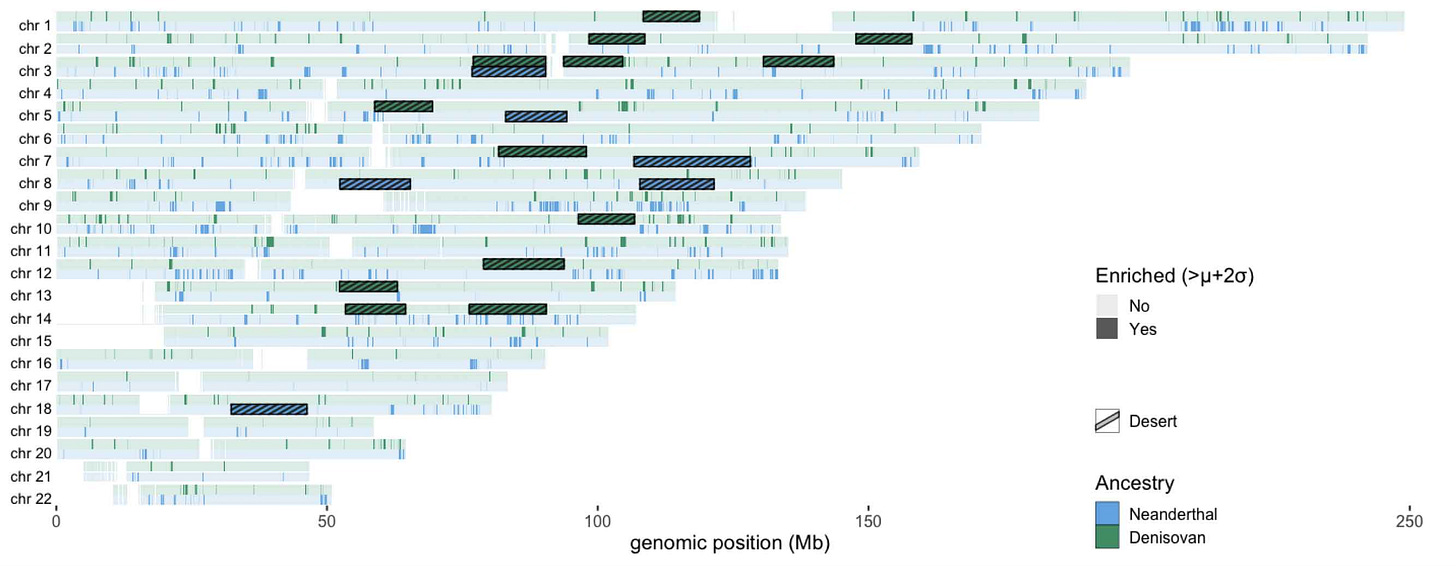
In the new study, Kerdoncuff and collaborators looked closely at Denisovan ancestry across India, finding that people in this region average around 0.1% Denisovan segments, with a range from 0.03% up to 0.17%. Just like the earlier study, the new research shows two distinct sources of Denisovan mixture—one close to Denisova 3, one much farther.
Those two Denisovan ancestry components occur on different proportions in people from north to south across India. The north-south gradient is a result of the more recent genetic history of the region, as early agricultural and Bronze Age peoples across India mixed with steppe peoples from the northwest, and East Asian peoples to the east and northeast. This history of gene flow during the last 6000 years was a result of long distance trade relationships and occasional large-scale invasions.
Denisovans are a far deeper legacy than the Bronze Age. In the north of India, Kerdoncuff and coworkers found the Altai Denisovan component of ancestry. This component may reflect gene flow from East Asia, since it is nearly absent from populations to the south.
Across all of India is evidence of mixture with a second group, divergent from the Denisova 3 genome. Sharing a bit less than 50% of the derived mutations that characterize the Altai branch, this more southern branch probably split off early in the Denisovan history, hundreds of thousands of years ago.
Who were they? One possibility is that this was the D2 group designated by Guy Jacobs and coworkers in their 2019 study of Papuan genome variation. That genetic mixture is reflected today in genomes in several parts of island Southeast Asia, with an estimated time of mixture around 46,000 years ago. Jacobs and collaborators did not specifically examine whether South Asian or Andamanese genomes may share this D2 signal.
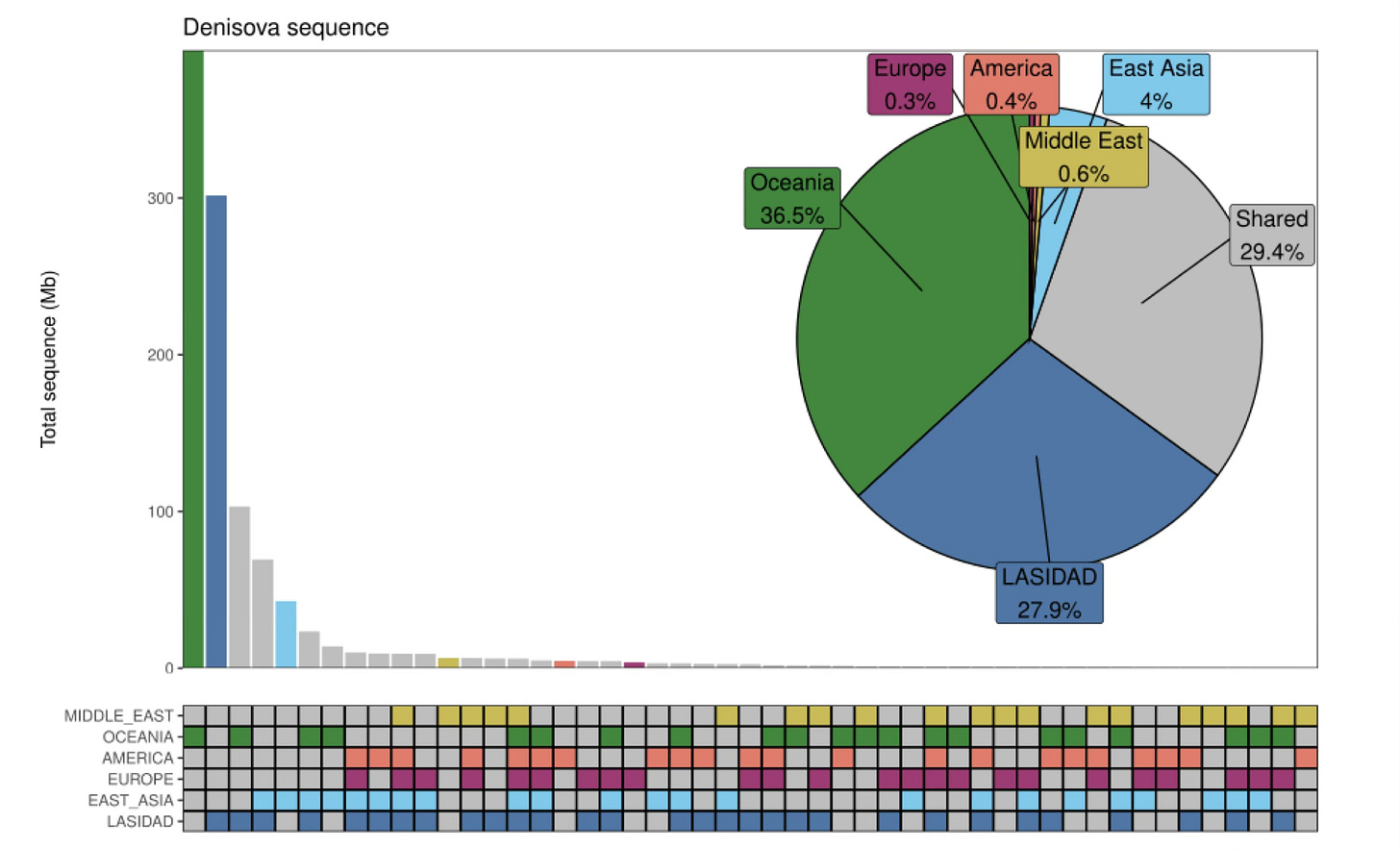
Another possibility is that South Asia had its own divergent Denisovan population. If so, this region may have been part of the deep-time interface of Neanderthals and Denisovans that also is evidenced by ancient DNA in the Altai.
Whatever the origin, the small fraction of Denisovan ancestry in India adds up to greater representation of the Denisovan genomes than anywhere else on the mainland of Asia. Kerdoncuff and coworkers identified around 500 megabases of Denisovan segments, including many with possible functional impacts, especially on immunity.
Close to Neanderthal mixture
India has more of the surviving diversity of Neanderthal genetics than any other part of the world. From the 2700+ genomes examined by Kerdoncuff and collaborators, they reconstructed more than 1.5 gigabases of the ancestral Neanderthal genome, or roughly half of the total amount. More than 11% of the Neanderthal segments identified in this study have never before been seen in any other population.
Another way of looking at the results is that less of the Neanderthal ancestry has been lost from India than any other region. More than 90% of the Neanderthal ancestral segments seen anywhere in the world today are present in India.
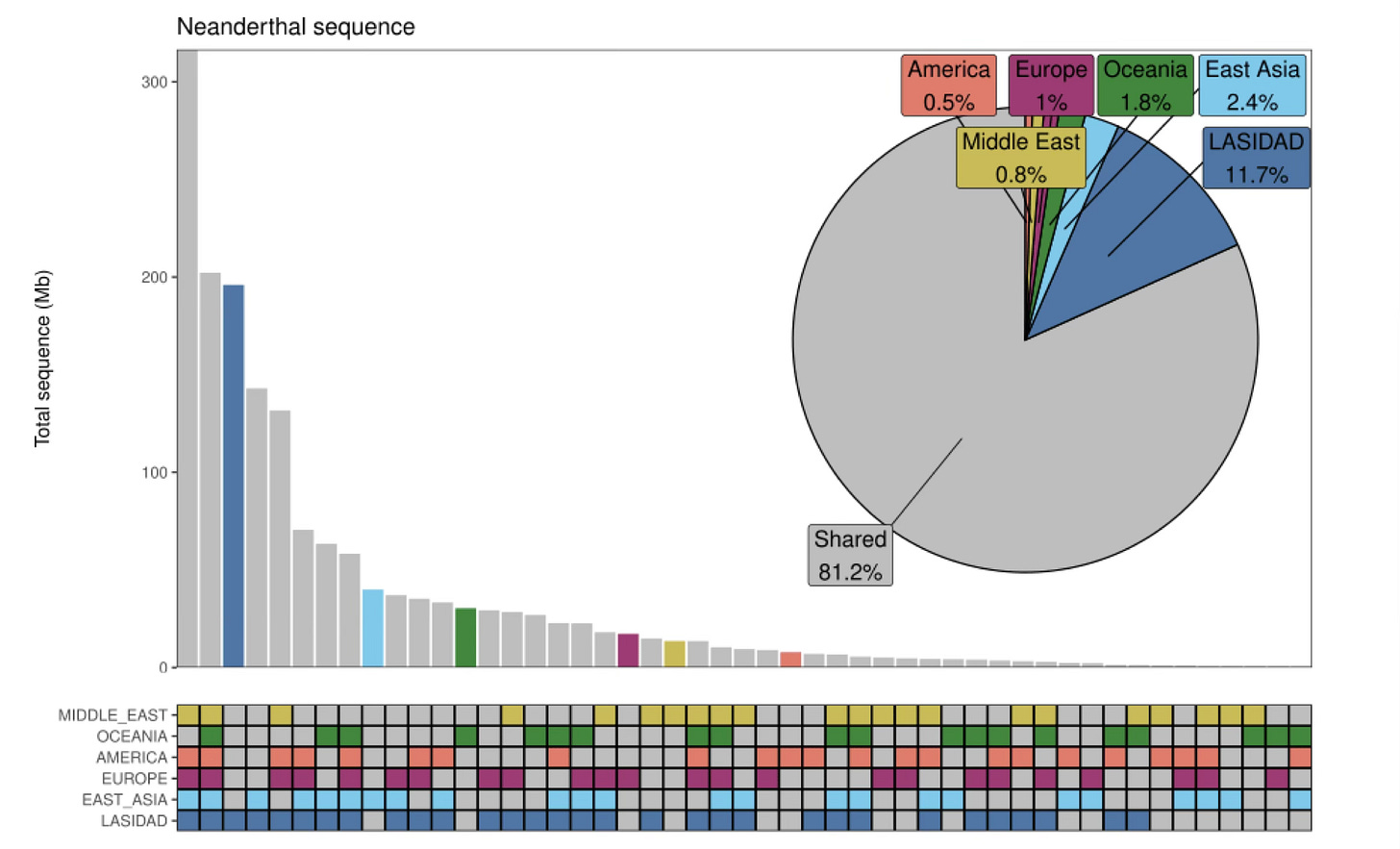
That’s true even though some East Asian populations have a higher fraction of genomic ancestry from Neanderthals. These populations have a lower number of Neanderthal segments, at slightly higher frequencies. This pattern is likely a result of early founder effects in the early habitation of East Asia. As a comparison: While more than 11% of the Neanderthal segments in today’s populations are uniquely found in India, only 2.4% are uniquely found in East Asia.
I interpret the high Neanderthal representation in India in light of the results earlier this year from Leonardo Iasi and collaborators. This team found that the Neanderthal ancestry found in today’s people was all consistent with a single extended pulse of mixture, from a single population source, centered on 47,000 years ago.
The Neanderthal DNA in these 2700+ people from India fits into this picture. South Asia may have been the first place that the dispersing population carried their newly-acquired Neanderthal heritage. With more remaining Neanderthal diversity, it’s clear that the geographic location where Neanderthal mixture happened must have been very close.
This key location may have been in present-day Iran or Pakistan, both areas where subsequent dispersal both to the north into Central Asia and to the east through India and Southeast Asia would have been natural results of population growth.
Timeline of dispersal
Kerdoncuff and collaborators considered whether the present-day populations of India all descend from a single major Out-of-Africa migration, or whether instead earlier coastal dispersals may be part of the ancestry of today’s populations. These aspects of the study are rooted in questions from archaeology.
Some archaeologists have argued that a “southern route” was important to the dispersal of modern humans from Africa. Under this concept, African people who had adapted to coastal life on the eastern coast of Africa spread northward, cruising across the Red Sea, along the southern coastline of Arabia and India, and ultimately reached island Southeast Asia and Australia. This was meant to explain how modern humans could have reached Australia before 50,000 years ago, while they entered Europe thousands of years later.
A related topic is the Toba volcanic eruption. Some archaeologists and geologists during the 1990s suggested that this event around 74,000 years ago had catastrophic impacts on Earth’s climate, possibly driving some hominin populations to extinction. In their view, the extinctions of Neanderthals and other archaic people paved the way for the expansion of modern human populations from Africa.
India plays a central role in both these ideas, and so archaeologists working in India have sometimes framed their work around when the southern route existed, and whether it was before or after the Toba eruption.
But each these core ideas has been modified over the years. There’s little evidence that the Toba eruption led to extinctions, and the few archaeological sites that can address what happened in South Asia show no sign of substantial interruption of human activity at the time the eruption happened. Meanwhile, the southern route idea has been bundled into the question of whether an “extinct out-of-Africa” population may have existed in East Asia and Southeast Asia prior to the major wave that happened after 50,000 years ago.
Kerdoncuff and coworkers looked at these issues through the perspective of minimum cross-coalescence of haplotypes in the India genomes compared to genomes from sub-Saharan Africa. The idea is that the genome segments now found in different populations must have shared common ancestors prior to the divergence of those populations. Tabulating these shared ancestors provides a kind of maximum age on the time that the populations parted ways.
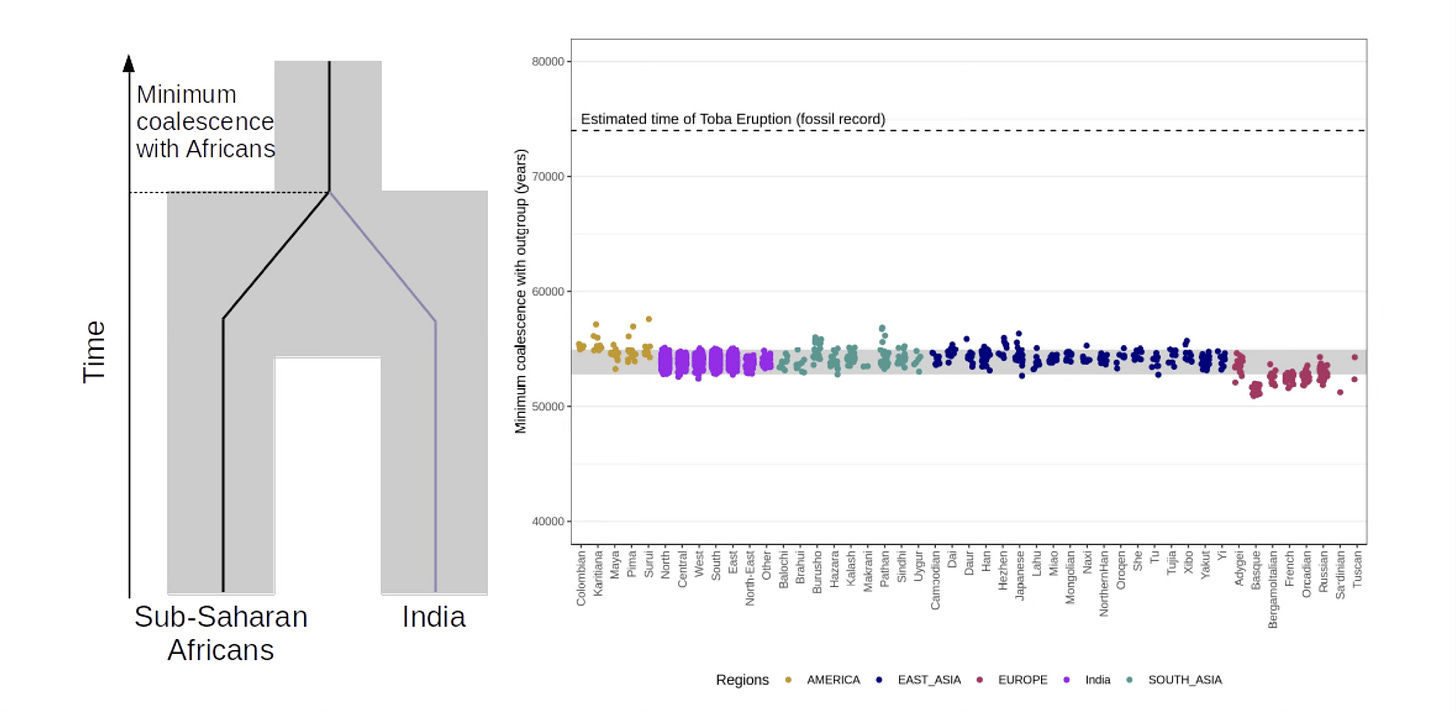
The results of the study suggest that the ancestral population of India separated from sub-Saharan African populations only around 54,000 years ago. This value is basically identical to every other region outside Africa, suggesting that a shared founder effect was present in the ancestry of all these people.
Now, I think that 54,000 years ago may be too recent. The minimum coalescence approach throws away a lot of information, and in this study relies on a single value assumed as the mutation rate. If the history was slightly more complex, with gene flow continuing for some time after the movement of people into southwest Asia, or a bit of variation in mutation and recombination rates, the divergence of the Eurasian and other populations from African populations might be a bit more or less.
Still, in comparison to my recent post about the Papuan population ancestry, a bottleneck of around 10,000 years of time followed by dispersal of the founder population after 44,000 years would look a lot like the results Kerdoncuff and coworkers report. And there is no hint here that the India population has a much deeper component of ancestry than any other population in Eurasia.
Even so, the data do not rule out some small genetic influence from an earlier dispersal. Kerdoncuff and coworkers report that they cannot exclude the hypothesis that as much as 3% of the ancestry of Indian genomes might derive from a “pre-Toba” population dispersal. I’m skeptical. A look at their results shows that while the data are not strong enough to rule out a small input, they certainly don’t rule out zero input, either. The idea that as much as 3% comes from an earlier dispersal reflects a lack of statistical power, not positive evidence.
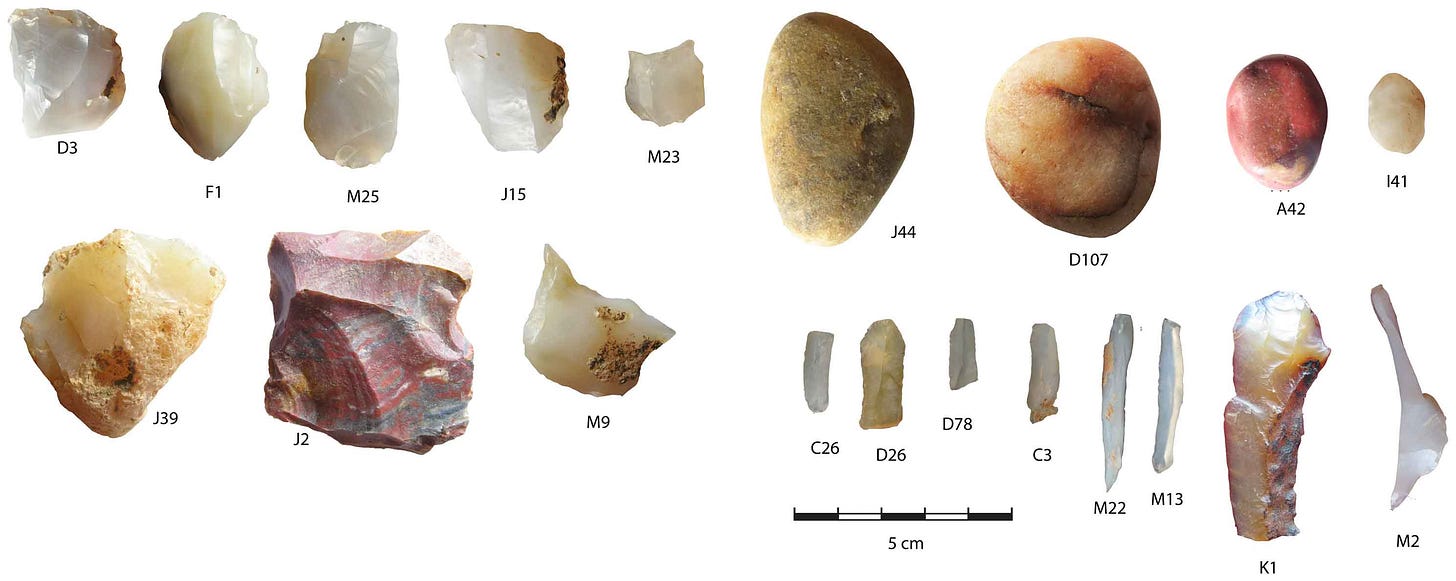
Bottom line
This is very important new data that adds a great deal to our ability to look at the dispersal of modern people. The analyses reinforce the scope of the shared founder effect that has previously been documented across many other populations of Eurasia, Oceania, and the Americas.
They also may help to bring resolution to a longstanding set of archaeological questions. Archaeological research from both northern and southern India has suggested a continuity of culture—at least, as reflected by stone tools made with techniques common in the Middle Paleolithic elsewhere—both before and after the time that the Toba volcanic eruption happened 74,000 years ago. One interpretation of such technical continuity, suggested by the archaeologist Michael Petraglia and collaborators in a 2011 study, and reinforced in a 2020 article, was that modern humans may have been present in the region long before Toba.
An alternative hypothesis, pushed forcefully by the late Paul Mellars, was that modern people never entered South Asia before the introduction of a microlith-based tool tradition after 50,000 years ago. Mellars thought that a rapid wave dispersed from Africa, carrying backed blades and microliths, that went on to inhabit Southeast Asia and Australia. Petraglia and coworkers suggested a different explanation for this shift in technology after 50,000 years ago, recognizing technical reorganization as an effect of population growth and environmental change.
Probably most archaeologists have trended toward a hybrid of these views. For example, Sheila Mishra and coworkers in a 2013 article suggested a two-phase scenario. In this view, an early dispersal of modern humans happened prior to 100,000 years ago, eventually inhabiting Southeast Asia and southern China. Much later, a subsequent migration brought new people into South Asia, maybe from Africa, introducing microlith-based tool traditions after 50,000 years ago.
Fifteen years ago, genetic information from the region was limited. Mitochondrial DNA suggested that South Asia had started its population growth earlier and faster than other regions of Eurasia. The timeline provided by Quentin Atkinson and coworkers in a 2008 paper suggested a “major South Asian chapter” in human dispersal, starting before 50,000 years ago. Mellars claimed strong support from genetics for his point of view, but others—including me—noted that uncertainty about mutation rates and sparse sampling of many important regions. To me, this left open the possibility that people with African connections had been present in South Asia far earlier than 50,000 years ago, maybe going back even earlier than 100,000 years ago.
The new data from whole genomes have persuaded me differently. They point to the rapid dispersal of modern humans into South Asia after the mixture with Neanderthals. Near the time of their arrival in India, these dispersing people quickly picked up additional genes from a divergent Denisovan group. That sequence of events doesn’t fit with a long previous occupation of the region by other modern people—at least, not unless those early modern people were living side-by-side with Denisovans throughout their existence.
References
Atkinson, Q. D., Gray, R. D., & Drummond, A. J. (2008). mtDNA Variation Predicts Population Size in Humans and Reveals a Major Southern Asian Chapter in Human Prehistory. Molecular Biology and Evolution, 25(2), 468–474. https://doi.org/10.1093/molbev/msm277
Browning, S. R., Browning, B. L., Zhou, Y., Tucci, S., & Akey, J. M. (2018). Analysis of Human Sequence Data Reveals Two Pulses of Archaic Denisovan Admixture. Cell, 173(1), 53-61.e9. https://doi.org/10.1016/j.cell.2018.02.031
Clarkson, C., Harris, C., Li, B., Neudorf, C. M., Roberts, R. G., Lane, C., Norman, K., Pal, J., Jones, S., Shipton, C., Koshy, J., Gupta, M. C., Mishra, D. P., Dubey, A. K., Boivin, N., & Petraglia, M. (2020). Human occupation of northern India spans the Toba super-eruption ~74,000 years ago. Nature Communications, 11(1), 961. https://doi.org/10.1038/s41467-020-14668-4
Kerdoncuff, E., Skov, L., Patterson, N., Banerjee, J., Khobragade, P., Chakrabarti, S. S., Chakrawarty, A., Chatterjee, P., Dhar, M., Gupta, M., John, J. P., Koul, P. A., Lehl, S. S., Mohanty, R. R., Padmaja, M., Perianayagam, A., Rajguru, C., Sankhe, L., Talukdar, A., … Moorjani, P. (2025). 50,000 years of evolutionary history of India: Impact on health and disease variation. Cell, 188(13), 3389-3404.e6. https://doi.org/10.1016/j.cell.2025.04.027
McColl, H., Racimo, F., Vinner, L., Demeter, F., Gakuhari, T., Moreno-Mayar, J. V., van Driem, G., Gram Wilken, U., Seguin-Orlando, A., de la Fuente Castro, C., Wasef, S., Shoocongdej, R., Souksavatdy, V., Sayavongkhamdy, T., Saidin, M. M., Allentoft, M. E., Sato, T., Malaspinas, A.-S., Aghakhanian, F. A., … Willerslev, E. (2018). The prehistoric peopling of Southeast Asia. Science, 361(6397), 88–92. https://doi.org/10.1126/science.aat3628
Mellars, P. (2006). Going East: New Genetic and Archaeological Perspectives on the Modern Human Colonization of Eurasia. Science, 313(5788), 796–800. https://doi.org/10.1126/science.1128402
Mellars, P., Gori, K. C., Carr, M., Soares, P. A., & Richards, M. B. (2013). Genetic and archaeological perspectives on the initial modern human colonization of southern Asia. Proceedings of the National Academy of Sciences, 110(26), 10699–10704. https://doi.org/10.1073/pnas.1306043110
Miller, E. F., Manica, A., & Amos, W. (2018). Global demographic history of human populations inferred from whole mitochondrial genomes. Royal Society Open Science, 5(8), 180543. https://doi.org/10.1098/rsos.180543
Mishra, S., Chauhan, N., & Singhvi, A. K. (2013). Continuity of Microblade Technology in the Indian Subcontinent Since 45 ka: Implications for the Dispersal of Modern Humans. PLOS ONE, 8(7), e69280. https://doi.org/10.1371/journal.pone.0069280
Petraglia, M., Korisettar, R., Boivin, N., Clarkson, C., Ditchfield, P., Jones, S., Koshy, J., Lahr, M. M., Oppenheimer, C., Pyle, D., Roberts, R., Schwenninger, J.-L., Arnold, L., & White, K. (2007). Middle Paleolithic Assemblages from the Indian Subcontinent Before and After the Toba Super-Eruption. Science, 317(5834), 114–116. https://doi.org/10.1126/science.1141564


Very informative, as usual!
I think there is zero real evidence for anything resembling a "coastal dispersion". It is a purely mental construct mainly to "explain" very early human presence in Australia and Island SEA.
There is neither archaeological nor genetic continuity along the Indian ocean coast. There is no indication that coastal living was preferable for early HS. Most of relevant archaeological sites in S Asia and Arabia are at a distance from coasts.
What I find also particularly contradicting the "coastal dispersion" theory is that the level of Neanderthal admixture in indigenous coastal people in SA and SEA is statistically very similar to all other Asians. There is no way it would happen if people settled the coast first and then expanded inland northward. It is clear people came to SA from the north first, not from the coast inland.
I am definitely with Petraglia, Dennel, etc. rather than Mellars on this. I think there is ample evidence of presence of early humans in Arabia and SA for a very long time, 400 kY or so. There is no evidence at all that they went completely extinct at any point.
Thanks for your rapid and substantial response! I'm looking eagerly for your upcoming post.
Geneticists and archeologists just warily circling points of disconnect? Not for the first time ... ;)